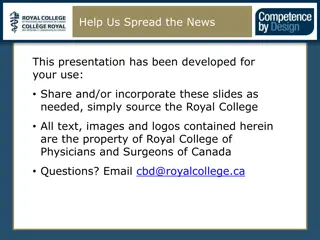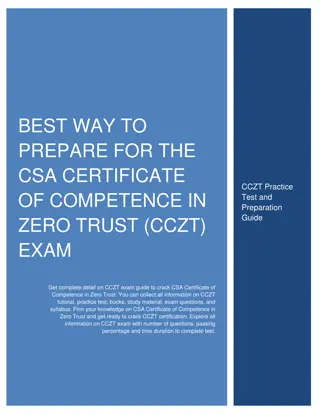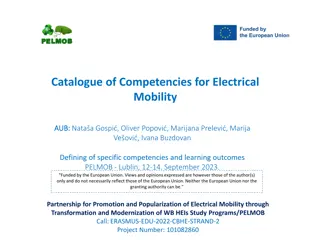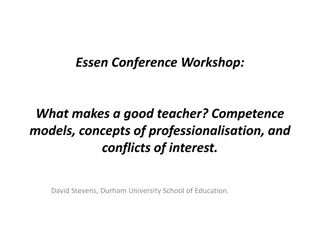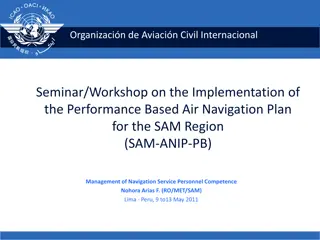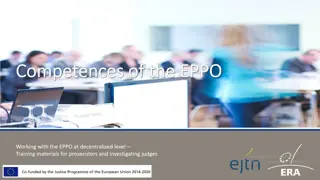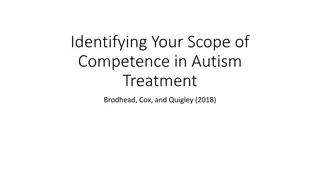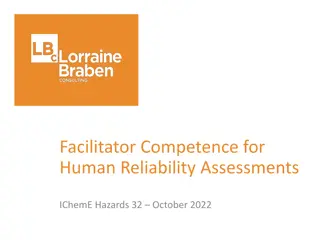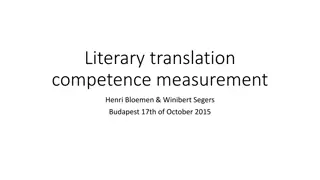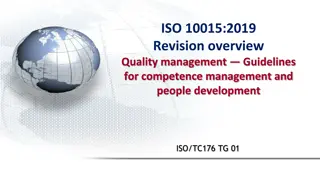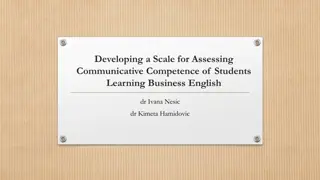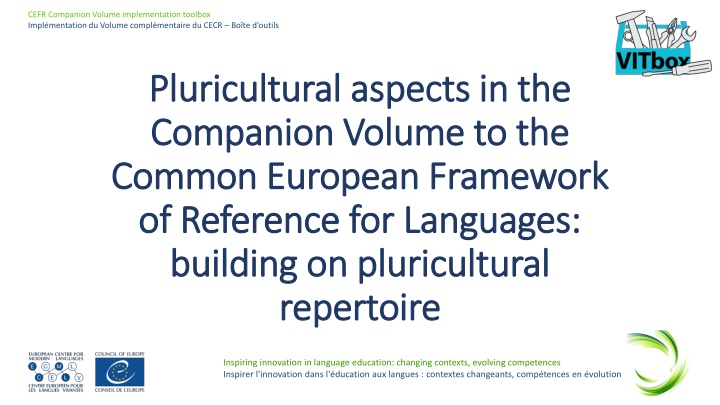
Building on Pluricultural Repertoire: Cultivating Competence
Pluricultural competence involves engaging with diverse cultures, promoting intercultural understanding, and fostering linguistic diversity. This dynamic skill set encourages learners to construct their cultural identity and establish connections between past experiences and new encounters. By encouraging interculturality and plurilingualism, we enable learners to participate in various cultural contexts, acquire multiple languages, and act in accordance with different perspectives. Embracing innovation in language education involves adapting to changing contexts and evolving competences within a democratic European culture.
Download Presentation

Please find below an Image/Link to download the presentation.
The content on the website is provided AS IS for your information and personal use only. It may not be sold, licensed, or shared on other websites without obtaining consent from the author. If you encounter any issues during the download, it is possible that the publisher has removed the file from their server.
You are allowed to download the files provided on this website for personal or commercial use, subject to the condition that they are used lawfully. All files are the property of their respective owners.
The content on the website is provided AS IS for your information and personal use only. It may not be sold, licensed, or shared on other websites without obtaining consent from the author.
E N D
Presentation Transcript
CEFR Companion Volume implementation toolbox Impl mentation du Volume compl mentaire du CECR Bo te d outils Pluricultural aspects in the Pluricultural aspects in the Companion Volume to the Companion Volume to the Common European Framework Common European Framework of Reference for Languages: of Reference for Languages: building on pluricultural building on pluricultural repertoire repertoire Inspiring innovation in language education: changing contexts, evolving competences Inspirer l'innovation dans l' ducation aux langues : contextes changeants, comp tences en volution
Building on pluricultural repertoire: the construct of Building on pluricultural repertoire: the construct of pluricultural competence pluricultural competence Pluriculturality is being able to identify and participate in other cultures, but the construct of pluricultural competence in the Companion Volume is more complex and includes the ability to understand otherness to encourage a democratic culture in Europe. Intercultural competence is the ability to experience otherness and cultural diversity and analyse it to derive a benefit, and once acquired, it can help understand otherness and establish cognitive links between past and new experiences of otherness. This leads to questioning the assumptions of your cultural group and environment. (Beacco et al., 2016: 10) Encouraging the diversity of languages and cultures involves helping learners to construct their linguistic and cultural identity with this positive experience of otherness and also encouraging them to learn by fostering the interaction between different languages and cultures. Inspiring innovation in language education: changing contexts, evolving competences Inspirer l'innovation dans l' ducation aux langues : contextes changeants, comp tences en volution
Building on pluricultural repertoire: the construct of pluricultural competence Building on pluricultural repertoire: the construct of pluricultural competence Interculturality and plurilingualism are intrinsically linked and by fostering one, we are necessary encouraging the other. Pluriculturality is the ability to participate in different cultures by acquiring several languages. Intercultural competence involves (1) knowledge (savoir), (2) understanding (savoir comprendre), (3) making the strange familiar and the familiar strange (savoir tre) and (4) acting accordingly to the new perspective (savoir s engager). (Byram, Gribkova and Starkey, 2002) Inspiring innovation in language education: changing contexts, evolving competences Inspirer l'innovation dans l' ducation aux langues : contextes changeants, comp tences en volution
Pluricultural competence is dynamic Plurilingual and pluricultural competence Life experiences affect cultural competence Building on pluricultural repertoire Plurilingual and pluricultural profiles are uneven Inspiring innovation in language education: changing contexts, evolving competences Inspirer l'innovation dans l' ducation aux langues : contextes changeants, comp tences en volution
Plurilingual and pluricultural competence Understanding cultural values and differences Sociolinguistic competence Avoiding cultural misunderstandings Dealing with cross-cultural communication Building on pluricultural repertoire Pragmatic competence Identifying cultural cues Understanding how culture influences behaviour FOSTERING OF SOCIAL COHESION Inspiring innovation in language education: changing contexts, evolving competences Inspirer l'innovation dans l' ducation aux langues : contextes changeants, comp tences en volution
C levels: C levels: understanding cultural backgrounds by linking culture to beliefs, values and practices. Capacity to be sensitive to differences and react constructively and with cultural appropriateness C1: Can identify differences in sociolinguistic/-pragmatic conventions, critically reflect on them and adjust their communication accordingly. B levels: B levels: identifying cultural cues and acting accordingly, explaining and discussing cultural features. Recognising cultural misunderstandings and taking action in repairing them. B2: Can, in an intercultural encounter, recognise that what one normally takes for granted in a particular situation is not necessarily shared by others, and can react and express themselves appropriately. A levels: A levels: recognising cultural differences and identifying potential communication problems, acting appropriately in simple everyday exchanges. A1: Can recognise differing ways of numbering, measuring distance, telling the time, etc. even though they may have difficulty applying this in even simple everyday transactions of a concrete type. Inspiring innovation in language education: changing contexts, evolving competences Inspirer l'innovation dans l' ducation aux langues : contextes changeants, comp tences en volution
Encouraging intercultural competence Encouraging intercultural competence [ ] the intercultural dimension in language teaching aims to develop learners as intercultural speakers or mediators who are able to engage with complexity and multiple identities and to avoid the stereotyping which accompanies perceiving someone through a single identity. (Byram et al., 2002: 9) Language competence includes linguistic, sociolinguistic and pragmatic knowledge, as well as skills and existential competences. Cultural competence refers to these skills but to those relevant to specific social groups who speak a given language and their cultures. Encouraging intercultural competence involves working with the learners on three pillars: their attitudes, their knowledge and understanding, and their skills. (Barret et al., 2014). Inspiring innovation in language education: changing contexts, evolving competences Inspirer l'innovation dans l' ducation aux langues : contextes changeants, comp tences en volution
If you want to know more If you want to know more Barrett, M. D., Huber, J., & Reynolds, C. (2014). Developing intercultural competence through education. Strasbourg: Council of Europe Publishing. Beacco, J., Byram, M., Cavalli, M., Coste, D., Cuenat, M. E., Goullier, F., & Panthier, J. (2016). Guide for the development and implementation of curricula for plurilingual and intercultural education. Strasbourg: Council of Europe. Language Policy Division. Byram, M., Gribkova, B. and Starkey, H. (2002). Developing the Intercultural Dimension in Language Teaching: A practical introduction for teachers. Strasbourg: Council of Europe. Cavalli, M., Coste, D., Cri an, A., & van de Ven, P. H. (2009). Plurilingual and intercultural education as a project. Languages in Education. Strasbourg: Council of Europe. Council of Europe (2001). Common European Framework of Reference for Languages: Learning, Teaching, Assessment. Cambridge: Cambridge University Press. Council of Europe (2011). European Language Portfolio: Principles and Guidelines. Strasbourg: Council of Europe. (Available at www.coe.int/portfolio) Council of Europe (2020). Common European Framework of Reference for Languages: Learning, Teaching, Assessment. Companion volume. Strasbourg: Council of Europe. Fleming, M., and Little, D. (2010). Languages in and for Education: a role for portfolio approaches? Strasbourg: Council of Europe. (Available at www.coe.int/lang NEWS INTERGOVERNMENTAL FORUM PROGRAMME AND DOCUMENTS) Inspiring innovation in language education: changing contexts, evolving competences Inspirer l'innovation dans l' ducation aux langues : contextes changeants, comp tences en volution


